In 2023, the U.S. experienced a record 25 billion-dollar weather and climate disasters — three more than the previous record, set in 2020.
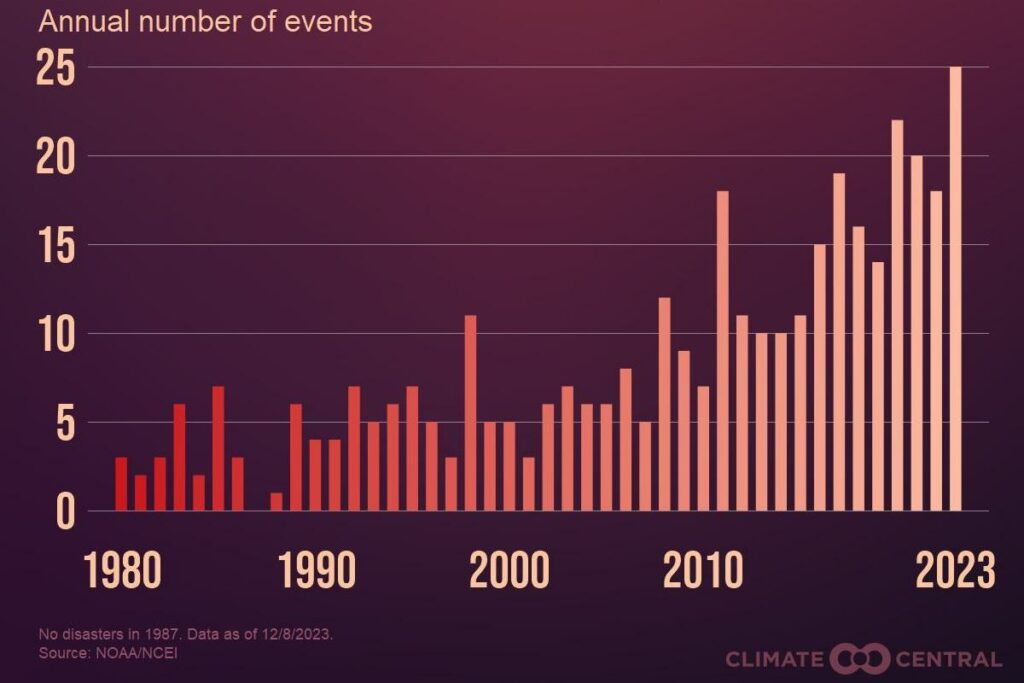
As greenhouse gases continue to accumulate in the atmosphere, extreme events — hurricanes, severe storms, heavy rainfall, flooding, wildfires, extreme heat, and drought — are becoming ever more frequent, intense, and dangerous. Between 1980 and 2022, the U.S averaged eight billion-dollar weather disasters each year, according to NOAA. Between 2018 and 2022, it recorded 18 such disasters on average. This year saw an unprecedented 25 billion-dollar disasters.
Not surprisingly, the average time between billion-dollar disasters has dramatically shrunk. In the 1980s, according to an analysis of government data by Climate Central, there was an average of 82 days between such disasters. Between 2018 and 2022, with more carbon in the atmosphere and more people and property in harm’s way, the lull between billion-dollar disasters dropped to an average of just 18 days. In the first eleven months of 2023, that lull was just 10 days.
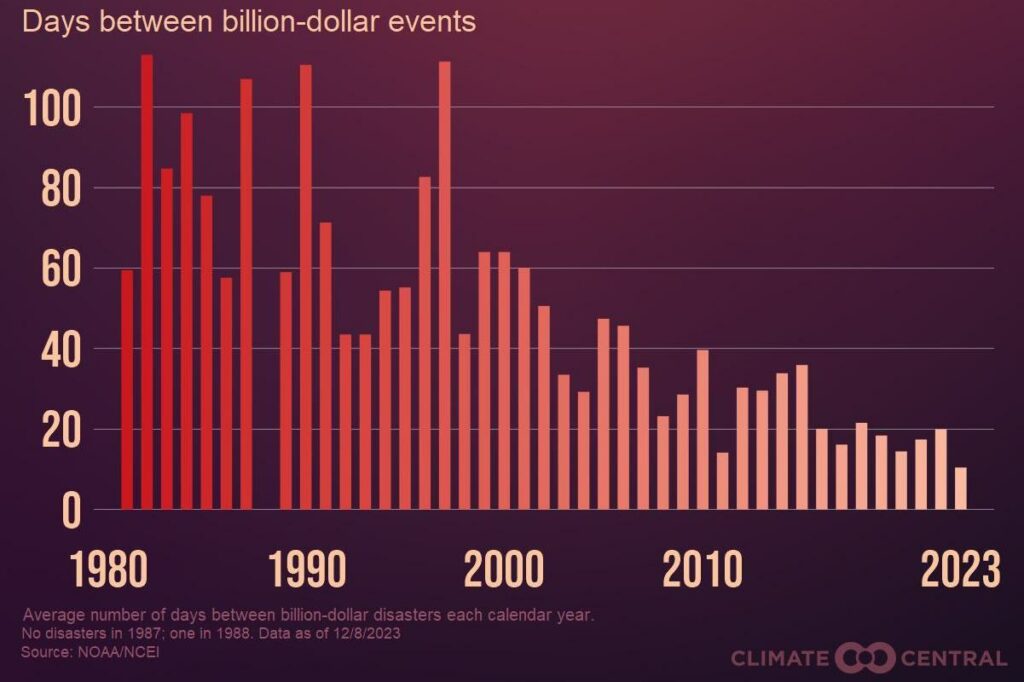
Today’s climate impacts reflect around 1.1 degrees C of global warming, said Climate Central, noting that impacts worsen with every bit of additional warming. But “if we commit to rapid and sustained cuts in carbon pollution, it could set younger generations on a path toward a far safer future with less warming and fewer risky extreme events.”
Here’s a breakdown
The year 2023 was marked by extraordinary heat, wildfires and weather disasters.
In the U.S., an unprecedented heat wave gripped much of Texas and the Southwest with highs well over 100 degrees Fahrenheit (37.8 Celsius) for the entire month of July.
Historic rainfall in April flooded Fort Lauderdale, Florida, with 25 inches of rain in 24 hours. A wave of severe storms in July sent water pouring into cities across Vermont and New York. Another powerful system in December swept up the Atlantic coast with hurricane-like storm surge and heavy rainfall. California faced flooding and mudslides from a series of atmospheric rivers early in the year, then was hit in August by a tropical storm – an extremely rare event there.
Wildfires ravaged Hawaii, Louisiana and several other states. And Canada’s worst fire season on record sent thick smoke across large parts of North America.
Globally, 2023 was the warmest year on record, and it wreaked havoc around the world. El Niño played a role, but global warming is at the root of the world’s increasing extreme weather.
So, how exactly is global warming linked to fires, storms and other disasters? I am an atmospheric scientist who studies the changing climate. Here’s what you need to know.
Dangerous heat waves and devastating wildfires
When greenhouse gases, such as carbon dioxide from vehicles and power plants, accumulate in the atmosphere, they act like a thermal blanket that warms the planet.
These gases let in high-energy solar radiation while absorbing outgoing low-energy radiation in the form of heat from the Earth. The energy imbalance at the Earth’s surface gradually increases the surface temperature of the land and oceans.
The most direct consequence of this warming is more days with abnormally high temperatures, as many countries saw in 2023.
Extreme heat waves hit large areas of North America, Europe and China, breaking many local high temperature records. Phoenix went 30 days with daily high temperatures at 110 F (43.3 C) or higher and recorded its highest minimum nighttime temperature, with temperatures on July 19 never falling below 97 F (36.1 C).
Although heat waves result from weather fluctuations, global warming has raised the baseline, making heat waves more frequent, more intense and longer-lasting.
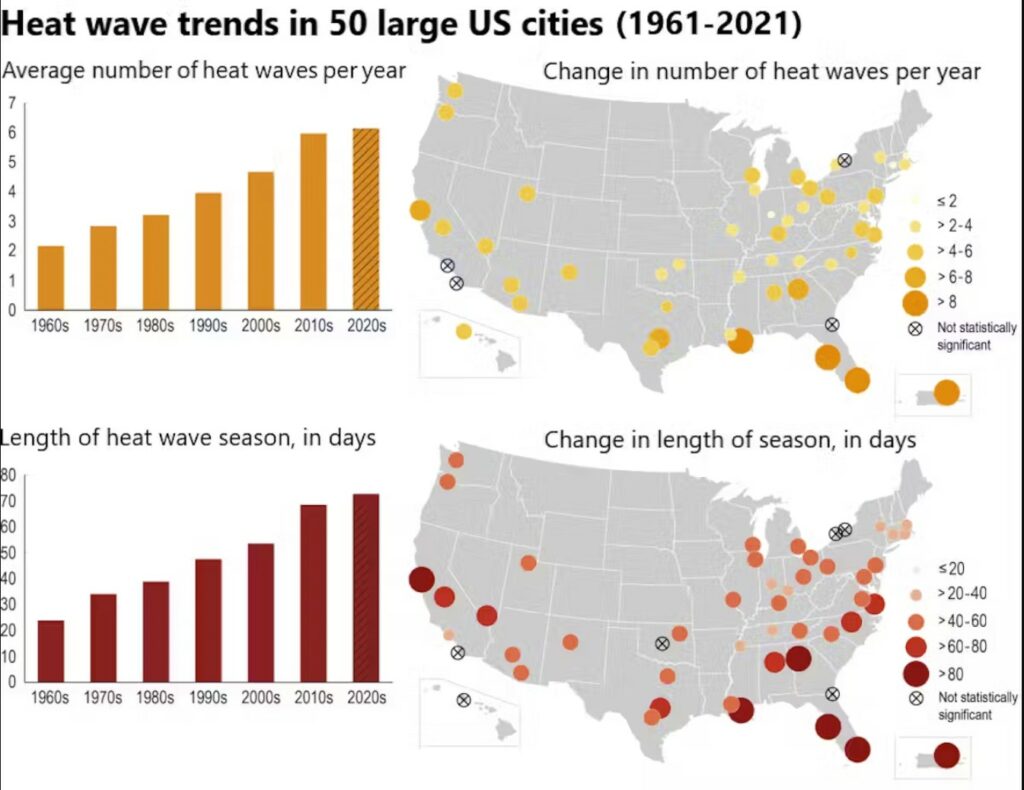
That heat also fuels wildfires.
Increased evaporation removes more moisture from the ground, drying out soil, grasses and other organic material, which creates favorable conditions for wildfires. All it takes is a lightning strike or spark from a power line to start a blaze.
Canada lost much of its snow cover early in 2023, which allowed the ground to dry and vast fires to burn through the summer. The ground was also extremely dry in Maui in August when the city of Lahaina, Hawaii, caught fire during a windstorm and burned.
How global warming fuels extreme storms
When temperatures are higher and the atmosphere has more moisture, that additional energy can fuel stronger, longer-lasting storms. This is the main reason for 2023’s record-breaking storms. Nineteen of the 25 weather and climate disasters that caused over US$1 billion in damage each through early December 2023 were severe storms, and two more were flooding that resulted from severe storms.
Tropical storms are similarly fueled by latent heat coming from warm ocean water. That is why they only form when the sea surface temperature reaches a critical level of around 80 F (27 C).
With 90% of the excess heat from global warming being absorbed by the ocean, there has been a significant increase in the global sea surface temperature, including record-breaking levels in 2023.
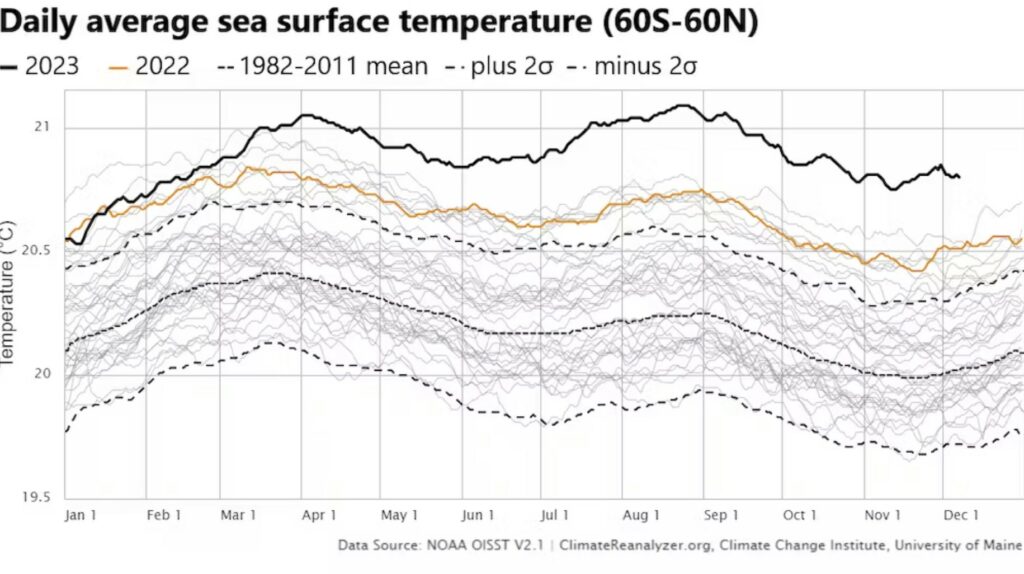
Higher sea surface temperatures can lead to stronger hurricanes and longer hurricane seasons. They can also lead to the faster intensification of hurricanes.
Hurricane Otis, which hit Acapulco, Mexico, in October 2023, was a devastating example. It exploded in strength, rapidly intensifying from a tropical storm to a destructive Category 5 hurricane in less than 24 hours. With little time to evacuate and buildings not designed to withstand a storm that powerful, more than 50 people died. The hurricane’s intensification was the second-fastest ever recorded, exceeded only by Hurricane Patricia in 2015.
US billion-dollar disasters by year
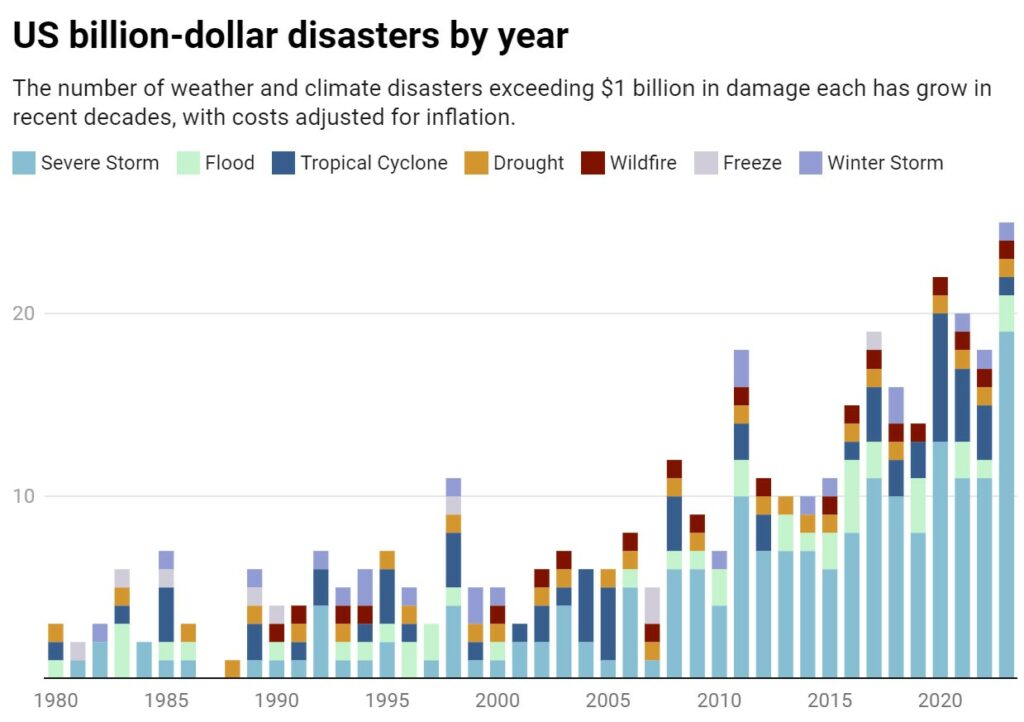
A recent study found that North Atlantic tropical cyclones’ maximum intensification rates increased 28.7% between the 1971-1990 average and the 2001-2020 average. The number of storms that spun up from a Category 1 storm or weaker to a major hurricane within 36 hours more than doubled.
The Mediterranean also experienced a rare tropical-like cyclone in September 2023 that offers a warning of the magnitude of the risks ahead – and a reminder that many communities are unprepared. Storm Daniel became one of the deadliest storms of its kind when it hit Libya. Its heavy rainfall overwhelmed two dams, causing them to collapse, killing thousands of people. The heat and increased moisture over the Mediterranean made the storm possible.
Cold snaps have global warming connections, too
It might seem counterintuitive, but global warming can also contribute to cold snaps in the U.S. That’s because it alters the general circulation of Earth’s atmosphere.
The Earth’s atmosphere is constantly moving in large-scale circulation patterns in the forms of near-surface wind belts, such as the trade winds, and upper-level jet streams. These patterns are caused by the temperature difference between the polar and equatorial regions.
As the Earth warms, the polar regions are heating up more than twice as fast as the equator. This can shift weather patterns, leading to extreme events in unexpected places. Anyone who has experienced a “polar vortex event” knows how it feels when the jet stream dips southward, bringing frigid Arctic air and winter storms, despite the generally warmer winters.
In sum, a warmer world is a more violent world, with the additional heat fueling increasingly more extreme weather events. [e360, Conversation]
Hey friends, it’s time to wake up!
If a few more people choose to support my work, I could expose more lies, root out more corruption, and call out more hypocrites. So, if you can afford it, please support my endeavor by either using PAYPAL or the DonorBox below (PAYPAL & Credit Cards / Debit Cards accepted)…
If you are a crypto fanatic, I do now accept crypto donations:
BTC: 1AjhUJM6cy8yr2UrT67iGYWLQNmhr3cHef (Network: Bitcoin) USDT: 0x490fe5d79d044a11c66c013e5b71305af0a76c1b (Network: Etherum ERC20)
You should join my newsletter to get a daily compilation of different breaking news, pictures and videos… YOU WILL LOVE IT!
Thank you,
Manuel












You’re full of camel poop, you live in Switzerland where all the escaped high ranking German Nazi’s fled to… you act like you care about America and other countries but you only post to what the feedback of the this website followers say, you worry more about getting money from your outlandish stories. Multiple times you have said different views and opinions on climate change, one of your recent posts was pro-climate change blaming CO2 for the cause of all these weather conditions. There are far worse gaseous substances that humans make that cause more havoc than CO2 does, such as Halon gas 1211 where one kilogram of it being released will destroy 50 tonnes of ozone…. this was a commonly used agent for fighting fires……
HAARP will be soon make pri big one quakes in CALIFORNIA? California floods weather abnormalities, WW3 and Iran will be the causes already
specially Iran says we made OCT 7 2023 then denies that , then saying we will make Israel to ashes because of General Soleimani. Now General
Reza Mussavi killed saying rubbish things again, we will destroy Israel and USA great Satan. We told here Iran has 100 Atom Bombs. Making
more PR Biden where are you nuke Iran now or never , Iran will be like North Korea soon will announce world they are fully atomic? Now N Korea
is saying they are ready to nuke great satan. See we must immidiatly plan to nuke Iran now end the all this terrors now they come to LAX airport
to dis ban cars and traveling so what happens when real global Intefada takes place ? Iranian in Iran and outside Iran we hate regime of Zahak
of Clergy like france we will kill all ayatoolahs soon. We Iranian are discussed from PLO , Hezboullah and Houtis , we want Reza Shah 2 now.
What is about climate engineering? I can’t read any word about that.
Horsefeathers!
Large cities have more concentrated human activity and larger building mass that holds heat causing what is depicted in the picture. The picture does not hold evidence for world wide “climate change”, but local climate change due to concentrated human activity in cities.
DUH, Ya think? HAARP type atmospheric heaters have been used clandestinely for more than a few decades, and the United States is not the only country with that type of technology. That tech, I believe, is now small enough to put on a mobile unit, instead of that huge array up in Gakona Alaska, which was given to the University of Alaska. Our government doesn’t just give up using that type of tech unless they have something far better, smaller and more powerful under wraps.